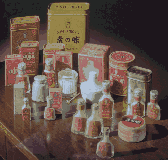Flavor Essence
http://www.100md.com
《e Natural Health Center》
 |
 |
Flavorings
Flavor Essence
Latin:
Sodium Glutamate, Monosodium Glutamate.
Origin:
The chemical name for Flavor Essence is monosodium glutamate. Monosodium glutamate was invented in 1908 by Dr. Kikunae Ikeda of Tokyo Imperial University.
, http://www.100md.com
In 1907, Professor Kikunae Ikeda noted "There is a taste which is common to asparagus, tomatoes, cheese and meat, but which is not one of the four well-known tastes of sweet, sour, bitter and salty."
He started experimental work on kombu seaweed (kelp), another source in which he found the taste was present. He succeeded in extracting crystals of glutamic acid----100 grams of kombu seaweed contain around 1 gram of glutamate. He noted that the glutamate had a distinctive taste, different from sweet, sour, bitter and salty. He later gave this taste the name "umami" (delicious).
, 百拇医药
The professor decided to create a seasoning from his newly extracted glutamate. To be used as a seasoning, his creation would need to have characteristics similar to those of sugar and salt, i.e., be easily water soluble, but neither absorb humidity, nor solidify. Monosodium glutamate (MSG) was found to have excellent storage properties, and had a rich "umami" taste. It turned out to be an ideal seasoning. Because MSG has no specific texture or taste, it can be used in a vast variety of dishes, naturally enhancing the original flavors of the food.
, http://www.100md.com
Commercial production of this monosodium glutamate was carried out by Saburosuke Suzuki, the founder of Ajinomoto Co., Inc., under request from Kikunae Ikeda. Dr. Ikeda's invention, sold under the Ajinomoto name, has become popular as a seasoning and a flavor enhancer not only in Japan, but worldwide. For example, the national consumption of MSG in the USA went from roughly one million pounds in 1950 to 300 times that amount today.
Though MSG was originally extracted from seaweed, it now is generally made from plants such as sugarbeets or cassava. The product starts from the fermentation of the natural material like sugarbeets or cassava, then hydrolyzed by hydrochloric acid and neutralized by caustic soda.
, 百拇医药
In recent years, MSG has gotten a bad rap and is often denounced as a "chemical". Proponents argue that other seasonings, such as vinegar, made by a similar process, aren't denounced as chemicals.
Properties:
Functions:
Applications:
Dosage and Administration:
, 百拇医药 Cautions on Use:
At higher doses, monosodium glutamate could become toxic enough to cause illness.
Reference Materials:
Toxic or Side Effects:
At higher doses, monosodium glutamate could become toxic enough to cause illness.
Modern Researches:
, http://www.100md.com
Monosodium glutamate (MSG) is a sodium salt of glutamate, or glutamic acid, an amino acid. Glutamate is a natural component, found in protein foods such as meat, poultry, vegetables and milk. Glutamate is also produced naturally in the human body. In total, the brain, body organs and muscles contain around four pounds of glutamate. Human Milk is also much richer in glutamate than cow's milk.
There are two forms of glutamate. Bound glutamate, which linked to amino acids forms a protein, and free glutamate. It is the free glutamate that has flavor enhancing qualities. Tomatoes and mushrooms, often used to boost flavor within foods, have high levels of naturally occurring free glutamate
, http://www.100md.com
Monosodium glutamate (MSG) acts as an excitatory neurotransmitter. It basically causes the nerve cells to discharge an electrical impulse and that is the basis of its use as a flavor enhancer.
Researchers have also discovered that MSG could suppress undesirable or "off" flavors, bitterness, and sourness and eliminated the "tinny" taste of canned foods.
As the dose of MSG increases, every single human will react to it at some point. At certain doses, it becomes toxic enough to cause illness.
Like sugar, MSG makes interesting patterns when dissolved and allowed to dry undisturbed. Under superstage lighting MSG crystals look like little jewels., http://www.100md.com